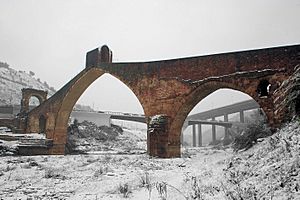Battle of Martorell (1641) facts for kids
Quick facts for kids Battle of Martorell |
|||||||
|---|---|---|---|---|---|---|---|
| Part of Reapers' War and the Franco-Spanish War (1635–59) |
|||||||
 Pont del Diable, from which the Catalan army retreated |
|||||||
|
|||||||
| Belligerents | |||||||
| Commanders and leaders | |||||||
The Battle of Martorell was an important fight during the Reapers' War in Catalonia. This battle took place from January 20 to 23, 1641. It ended with a victory for the Spanish troops. Martorell is a town in Catalonia, a region in Spain.
Contents
What Led to the Battle?
Tensions Rise in Catalonia
In the spring of 1640, a leader named Francesc de Tamarit was put in prison. He was accused of not helping the army with supplies and places to stay. But angry farmers and common people, known as "reapers," marched into Barcelona on May 22. They freed Tamarit from prison.
On June 7, 1640, during an event called the Corpus of Blood, more groups of reapers entered Barcelona. The Viceroy of Catalonia, Dalmau de Queralt, who was the king's representative, was killed during these events.
Spanish Army Advances
In September, the army of King Philip IV of Spain began to move. This army was led by Pedro Fajardo, the Marquess of Los Vélez. In December, they took control of Tortosa. After another battle near Cambrils, they also captured the city of Tarragona. Their goal was to reach Barcelona.
A Catalan leader named Francesc de Vilaplana watched the Spanish army's movements. He had two groups of Catalan cavalry (soldiers on horseback) and one French group. These groups had not surrendered with Tarragona.
Catalonia Seeks French Help
The Catalan and French forces decided to stop the Spanish army in Martorell. This town became the main base for the Catalan army. This happened after Roger de Bossost, Baron of Espenan, gave up Tarragona and left with his troops for France.
Just four days before the battle, the Junta de Braços (which was like a parliament or general assembly) of Catalonia made a big decision. Led by Pau Claris, the President of the Generalitat, they declared Catalonia a Republic. They asked France for protection and support.
The Battle of Martorell
First Moves
On January 20, Pedro Fajardo, the Marquis de los Vélez, sent a large group of his soldiers. They went through Gelida and Castellví de Rosanes. Their plan was to block the Catalan troops from escaping along the right side of the Llobregat River. However, these Spanish soldiers were pushed back by Catalan fighters called miquelets, led by Dídac de Vergós.
Retreat Across the Devil's Bridge
On January 21, the main part of the Spanish royal army arrived at the Llobregat River. Their infantry (foot soldiers) were led by the Marquis de San Jorge. This arrival forced the Catalan army to leave Martorell. The Catalans crossed the Pont del Diable (Devil's Bridge) to avoid being trapped. French artillery (big guns) covered their retreat, protecting them as they moved.
The Spanish soldiers then entered Martorell. The mayor of Martorell, who was wearing his official symbols, tried to stop the Spanish from taking over the town forcefully. Sadly, he was killed. It seems the Marquis de Los Vélez was very angry with the people of Martorell. He felt they had betrayed both the King and him, as Martorell was a town under his control.
Fall of Martorell
When the Spanish cavalry, led by the Marquis de Torrecuso, crossed the Llobregat River, the Catalans had no choice but to retreat further towards Barcelona. This defeat at Martorell meant the Spanish army was now very close to Barcelona.
Because of this difficult situation, the Catalans decided to ask King Louis XIII of France to become their new Count of Barcelona. This happened on January 23. King Louis XIII then sent an army to Catalonia to help his new subjects. However, just three days later, on January 26, the Catalan and French armies fought the Spanish troops again. This time, at the Battle of Montjuïc near Barcelona, the Catalan and French forces won.
See also
 In Spanish: Batalla de Martorell para niños
In Spanish: Batalla de Martorell para niños

